Modelling and Analysis of Hydrodynamics and Water Quality for Rivers in the Northern Cold Region of China
Abstract
:1. Introduction
2. Selection of Research Area and Simulated Pollutants
3. Introduction to the Model
4. Model Construction
4.1. Simulation Range and Time Interval
4.2. Grid Division and Boundary Condition Setting
4.2.1. Grid Division
4.2.2. Boundary Conditions
4.3. Model Parameters and Calibration Method
5. Validation of Hydrodynamics
6. Validation of Water Quality
6.1. Parameter Calibration Result Analysis
6.2. Simulated Result Analysis
6.3. Problem Analysis
6.3.1. Error of Bottom Elevation Generalization
6.3.2. Variability of Pollution Sources Discharged into the Watercourse from Urban Storm Drainage Pipe Networks and Sewage Pipes
6.3.3. Dispersed Non-point Agricultural Source Pollution on Each Side of the Trunk Stream and Relevant Measurement Difficulties
7. Conclusions
- (1)
- Research findings show that the concentration simulation errors of CODCr in the four sections used for model verification range from 5.86% to 18.43%; while for those of NH3N, are between 14.88% and 39.58%.
- (2)
- The decay rate of CODCr and NH3N during the ice-covered period is lower than that in the open-water period. According to the research results, in the trunk stream of the Mudan River, the decay rates of CODCr and NH3N during the open-water period are 0.03/day and 0.05/day while they are 0.01/day and 0.02/day during the ice-covered period.
- (3)
- For this research, the roughness adopted for the ice-covered period was 0.043 and 0.035 for the open-water period. The obtainment of favorable simulation effects indicates that these two parameters were selected appropriately.
- (4)
- Comparing with the decay rates of other rivers in China, those of CODCr and NH3N in the Mudan River are relatively lower. This may be due to the low annual average temperature of this river which is located in the cold north region.
- (5)
- Within the research area, due to the lack of measured data about the non-point source pollution sources, the NH3N simulation precision is lower than that of CODCr, so monitoring of the non-point source pollution should be enhanced for the Mudan River watershed in order to fully grasp the NH3N pollution pattern and further improve the NH3N simulation precision.
Acknowledgments
Author Contributions
Conflicts of Interest
References
- Manolidis, M.; Katopodes, N. Bed scouring during the release of an ice jam. J. Mar. Sci. Eng. 2014, 2, 370–385. [Google Scholar] [CrossRef]
- Fu, C.; Popescu, I.; Wang, C.; Mynett, A.E.; Zhang, F. Challenges in modelling river flow and ice regime on the Ningxia–Inner Mongolia reach of the Yellow River, China. Hydrol. Earth Syst. Sci. 2014, 18, 1225–1237. [Google Scholar] [CrossRef]
- Beltaos, S. Hydrodynamic and climatic drivers of ice breakup in the lower Mackenzie River. Cold Reg. Sci. Technol. 2013, 95, 39–52. [Google Scholar] [CrossRef]
- Gebre, S.; Timalsina, N.; Alfredsen, K. Some aspects of ice-hydropower interaction in a changing climate. Energies 2014, 7, 1641–1655. [Google Scholar] [CrossRef]
- Hou, R.J.; Li, H.M. Modelling of BOD-DO dynamics in an ice-covered river in Northern China original. Water Res. 1987, 21, 247–251. [Google Scholar]
- Chambers, P.A.; Brown, S.; Culp, J.M.; Lowell, R.B.; Pietroniro, A. Dissolved oxygen decline in ice-covered rivers of Northern Alberta and its effects on aquatic biota. J. Aquat. Ecosyst. Stress Recover. 2000, 8, 27–38. [Google Scholar] [CrossRef]
- Terzhevik, A.; Golosov, S.; Palshin, N.; Mitrokhov, A.; Zdorovennov, R.; Zdorovennova, G.; Kirillin, G.; Shipunova, E.; Zverev, I. Some features of the thermal and dissolved oxygen structure in boreal, shallow ice-covered Lake Vendyurskoe, Russia. Aquat. Ecol. 2009, 43, 617–627. [Google Scholar] [CrossRef]
- Gotovtsev, A.V. A new method for estimating BOD and the rate of biochemical oxidation based on modified Streeter-Phelps equations. Water Res. 2014, 41, 330–334. [Google Scholar] [CrossRef]
- Sun, S.C.; Wei, H.B.; Xiao, W.H.; Zhou, Z.H.; Wang, H.; He, H.X. Application of the freezing period hydrodynamics and water quality model to water pollution accident in Songhua River. J. Jilin Univ. 2011, 41, 1548–1553. (In Chinese) [Google Scholar]
- Oveisy, A.; Boegman, L.; Rao, Y.R. A model of the three-dimensional hydrodynamics, transport and flushing in the Bay of Quinte. J. Gt. Lakes Res. 2015, 41, 536–548. [Google Scholar] [CrossRef]
- Sugihara, K.; Nakatsugawa, M. Water quality observations of ice-covered, stagnant, eutrophic water bodies and analysis of influence of ice-covered period on water quality. Biosci. Biotechnol. Biochem. 2015, 79, 1–13. [Google Scholar]
- Wang, M.; Xing, J.; Sun, W.; Li, J.; Pan, B. Study on pollution prevention counter measures in Mudan River Basin during 12th fyp period. Environ. Sci. Manag. 2013, 38, 100–133. (In Chinese) [Google Scholar]
- Hao, Y.; Sun, W.G.; Yu, Z.B. Study on pollution of various sections in Mudanjiang River Basin by equal standard pollution load method. Mod. Agric. Sci. Technol. 2013, 16, 217–218. (In Chinese) [Google Scholar]
- Delft3D-FLOW. Simulation of Multi-Dimensional Hydrodynamic Flows and Transport Phenomena, Including Sediments—User Manual; Delft3D-FLOW: Delft, The Netherlands, 2006. [Google Scholar]
- Ambrose, R.B.; Wool, T.A.; Martin, J.L. The Water Quality Analysis Simulation Program WASP5, Part A: Model Documentation; U.S. EPA: Athens, GA, USA, 1993.
- Danish Hydraulic Institute. A Modelling System for Rivers and Channels: Reference Manual; Danish Hydraulic Institute: Hørsholm, Denmark, 2004. [Google Scholar]
- Danish Hydraulic Institute. MIKE21 User Guide; Danish Hydraulic Institute Water an Environment: Hørsholm, Denmark, 2005. [Google Scholar]
- Danish Hydraulic Institute. MIKE 3 Estuarine and Coastal Hydraulics and Oceanography Hydraulic Module Reference Manual; Danish Hydraulic Institute: Hørsholm, Denmark, 2002. [Google Scholar]
- Cole, T.M.; Well, S.A. CE-QUAL-W2: A Two-Dimensional, Laterally Averaged, Hydrodynamic and Water Quality Model, Version 3.6; Department of Civil and Environmental Engineering, Portland State University: Portland, OR, USA, 2008. [Google Scholar]
- Harmick, J.M. A Three-Dimensional Environmental Fluid Dynamics Computer Code: Theoretical and Computational Aspects; The College of William and Mary, Virginia Institute of Marine Science: Williamsburg, VA, USA, 1992. [Google Scholar]
- Kuo, A.Y.; Shen, J.; Hamrick, J.M. The effect of acceleration on bottom shear stress in tidal estuaries. ASCE J. Waterw. Port Coast. Ocean. Eng. 1996, 122, 75–83. [Google Scholar] [CrossRef]
- Wu, G.; Xu, Z. Prediction of algal blooming using EFDC model: Case study in the Daoxiang Lake. Ecol. Model. 2011, 222, 1245–1252. [Google Scholar] [CrossRef]
- Sucsy, P.V.; Morris, F.W.; Bergman, M.J.; Donnangelo, L.J. A 3-D model of Florida’s Sebastian River Estuary, estuarine and coastal modeling. In Proceedings of the 5th International Conference, ASCE, Alexandria, VA, USA, 14–22 October 1997; pp. 59–74.
- Shen, J.; Boon, J.D.; Kuo, A.Y. A modeling study of a tidal intrusion front and its impact on larval dispersion in the James River Estuary, Virginia. Estuaries 1999, 22, 681–692. [Google Scholar] [CrossRef]
- Hamrick, J.M.; Mills, W.B. Analysis of water temperatures in Conowingo Pond as influenced by the Peach Bottom atomic power plant thermal discharge. Environ. Sci. Policy 2000, 3, 197–209. [Google Scholar] [CrossRef]
- Moustafa, M.Z.; Hamrick, J.M. Calibration of the wetland hydrodynamic model to the Everglades Nutrient Removal Project. Water Qual. Ecosyst. Model. 2000, 1, 141–167. [Google Scholar] [CrossRef]
- Boussinesq, J. Theorie Aanalyque de la Chaleur; Gathier-Villars: Paris, France, 1903. [Google Scholar]
- Mellor, G.L.; Yamada, T. Development of a turbulence closure model for geophysical fluid problems. Rev. Geophys. Space Phys. 1982, 20, 851–875. [Google Scholar] [CrossRef]
- Arakawa, A.; Lamb, V.R. Computational design of the basic dynamical processes of the UCLA general circulation model. Methods Comput. Phys. 1977, 17, 174–265. [Google Scholar]
- Madala, R.V.; Piacsek, S.A. A semi-implicit numerical model for Baroclinic Oceans. J. Comput. Phys. 1977, 23, 167–178. [Google Scholar] [CrossRef]
- Sheng, Y.P.; Butler, H.L. Modeling coastal currents and sediment transport. In Proceedings of the 18th International Conference on Coastal Engineering, ASCE, New York, NY, USA, 15 January 1982; pp. 1127–1148.
- Smolarkiewicz, P.K.; Margolin, L.G. On forward-in-time differencing for fluids: Extension to a curvilinear framework. Mon. Weather Rev. 1993, 121, 1847–1859. [Google Scholar] [CrossRef]
- Sheng, Y.P. Finite-Difference Models for Hydrodynamics of Lakes and Shallow Seas. Physics-Based Modeling of Lakes, Reservoirs, and Impoundments; Gray, W.G., Ed.; ASCE: New York, NY, USA, 1986; pp. 146–228. [Google Scholar]
- Smolarkiewicz, P.K.; Clark, T.L. The multidimensional positive definite advection transport algorithm: Further development and applications. J. Comput. Phys. 1986, 67, 396–438. [Google Scholar] [CrossRef]
- Smolarkiewicz, P.K.; Grabowski, W.W. The multidimensional positive definite advection transport algorithm: Nonoscillatory option. J. Comput. Phys. 1990, 86, 355–375. [Google Scholar] [CrossRef]
- Debolskaya, E.I.; Isaenkov, A.Y. Mathematical modeling of the transportation competency of an ice covered flow. Hydrophys. Process. 2010, 37, 558–567. [Google Scholar] [CrossRef]
- Li, Y.P.; Wang, Y.; Tang, C.Y.; Anim, D.O.; Ni, L.X.; Yu, Z.B.; Acharya, K. Measurements of erosion rate of undisturbed sediment under different hydrodynamic conditions in Lake Taihu, China. Pol. J. Environ. Stud. 2014, 23, 1235–1244. [Google Scholar]
- Qu, M.Y.; Li, T. Analysis of river sediment supply in middle and downstream section of Mudanjiang River mainstream. Heilongjiang Sci. Technol. Water Conserv. 2013, 41, 38–40. (In Chinese) [Google Scholar]
- Wang, M.; Li, W.J.; Ye, Z. Optimization on water environment capacity and distribution in Mudan River West Pavilion to Chai River Bridge Section. Environ. Sci. Manag. 2013, 38, 40–44. (In Chinese) [Google Scholar]
- Chen, S.S.; Fang, L.G.; Li, H.L.; Zhang, L.X. Saltwater intrusion analysis experiential model for Pearl River Estuary, South China: A case study in Modaomen watercourse. Adv. Water Sci. 2007, 18, 751–755. (In Chinese) [Google Scholar]
- Long, T.G.; Guo, J.S.; Feng, Y.Z.; Huo, G.Y. Modulus of transverse diffuse simulation based on artificial Weural network. Chong Qing Environ. Sci. 2002, 24, 25–28. (In Chinese) [Google Scholar]
- Huang, W.; Liu, X.; Chen, X. Numerical modeling of hydrodynamics and salinity transport in Little Manatee River. J. Coast. Res. 2008, 52, 13–24. [Google Scholar] [CrossRef]
- HydroQual Inc. A Primer for ECOMSED, Version 1.3; HydroQual Inc.: Mahwah, NJ, USA, 2002. [Google Scholar]
- Nares, C.; Subuntith, N.; Sukanda, C. Empowering water quality management in Lamtakhong River Basin, Thailand using WASP model. Res. J. Appl. Sci.: Eng. Technol. 2013, 6, 4485–4491. [Google Scholar]
- Wool, T.A.; Davie, S.R.; Rodriguez, H.N. Development of three-dimensional hydrodynamic and water quality models to support total maximum daily load decision process for the Neuse River Estuary, North Carolina. J. Water Res. Plan. Manag. 2003, 129, 295–306. [Google Scholar] [CrossRef]
- Sperling, M.V.; Paoli, A.C. First-order COD decay coefficients associated with different hydraulic models applied to planted and unplanted horizontal subsurface-flow constructed wetlands. Ecol. Eng. 2013, 57, 205–209. [Google Scholar] [CrossRef]
- Guo, R.; Li, Y.B.; Fu, G. Controlling factors of degradation coefficient on organic pollutant in river. J. Meteorol. Environ. 2008, 24, 56–59. (In Chinese) [Google Scholar]
- Weiler, R.R. Rate of loss of ammonia from water to the atmosphere. J. Fish. Res. Board Can. 2011, 36, 685–689. [Google Scholar] [CrossRef]
- Stratton, F.E. Nitrogen losses from alkaline water impoundments. J. Sani. Eng. Div. 1969, 95, 223–231. [Google Scholar]
- Druon, J.N.; Mannino, A.; Signorini, S.; Mcclain, C.; Friedrichs, M.; Wilkin, J.; Fennel, K. Modeling the dynamics and export of dissolved organic matter in the northeastern U.S. continental shelf. Estuar. Coast. Shelf Sci. 2010, 88, 488–507. [Google Scholar] [CrossRef]
- Wright, R.M.; Medonell, A.J. In-stream de-oxygenation rate prediction. Proc. ASCE J. Environ. 1979, 105, 323–335. [Google Scholar]
- Pu, X.C.; Li, K.F.; Li, J.; Zhao, W.Q. The effect of turbulence in water body on organic compound biodegradation. China Environ. Sci. 1999, 19, 485–489. (In Chinese) [Google Scholar]
- Wang, X.E.; Dong, D.M.; Zhao, W.J.; Li, J.; Zhang, H.L.; Du, Y.G. Reduction mode of organic pollutants in rivers during the icebound season. J. Jilin Univ. 2003, 3, 392–395. (In Chinese) [Google Scholar]
- Wang, Z.B.; Ma, Y.; Sun, W.G. Discussion about the control technologies of non-point pollution of Mudanjiang River Basin. Environ. Sci. Manag. 2011, 7, 3659–3662. (In Chinese) [Google Scholar]
- Fischer, H.B.; List, E.J.; Koh, R.C.Y.; Imberger, J.; Brooks, N.H. Chapter 5—Mixing in rivers. In Mixing in Inland & Coastal Waters; ACADEMIC PRESS, Inc.: San Diego, CA, USA, 1979; Volume 13, pp. 104–147. [Google Scholar]
- Chui, X.D.; Liu, B.C. Research and control of Mudanjiang River non-spot source water environment pollution. North. Environ. 2005, 3, 70–71. (In Chinese) [Google Scholar]
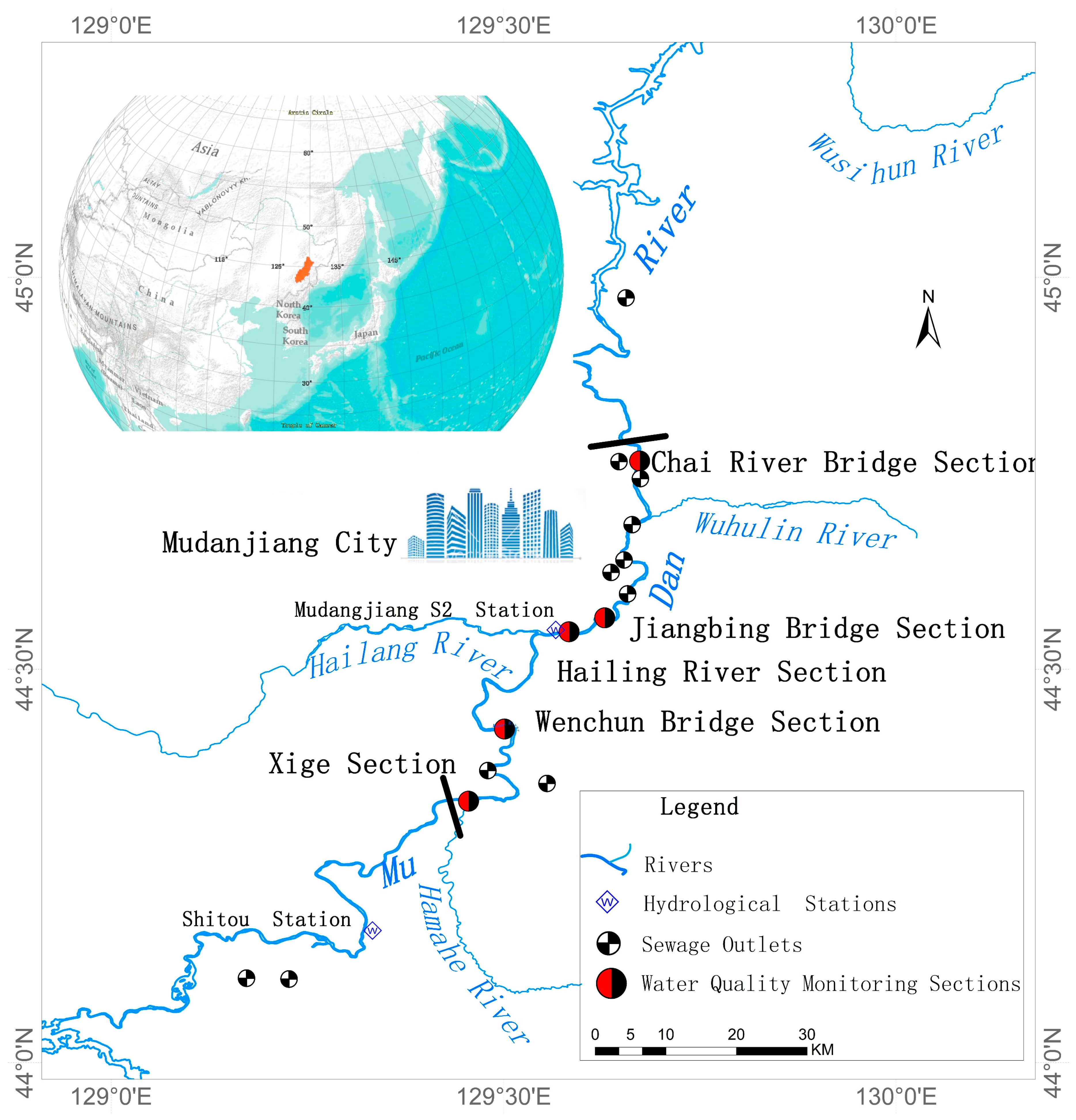
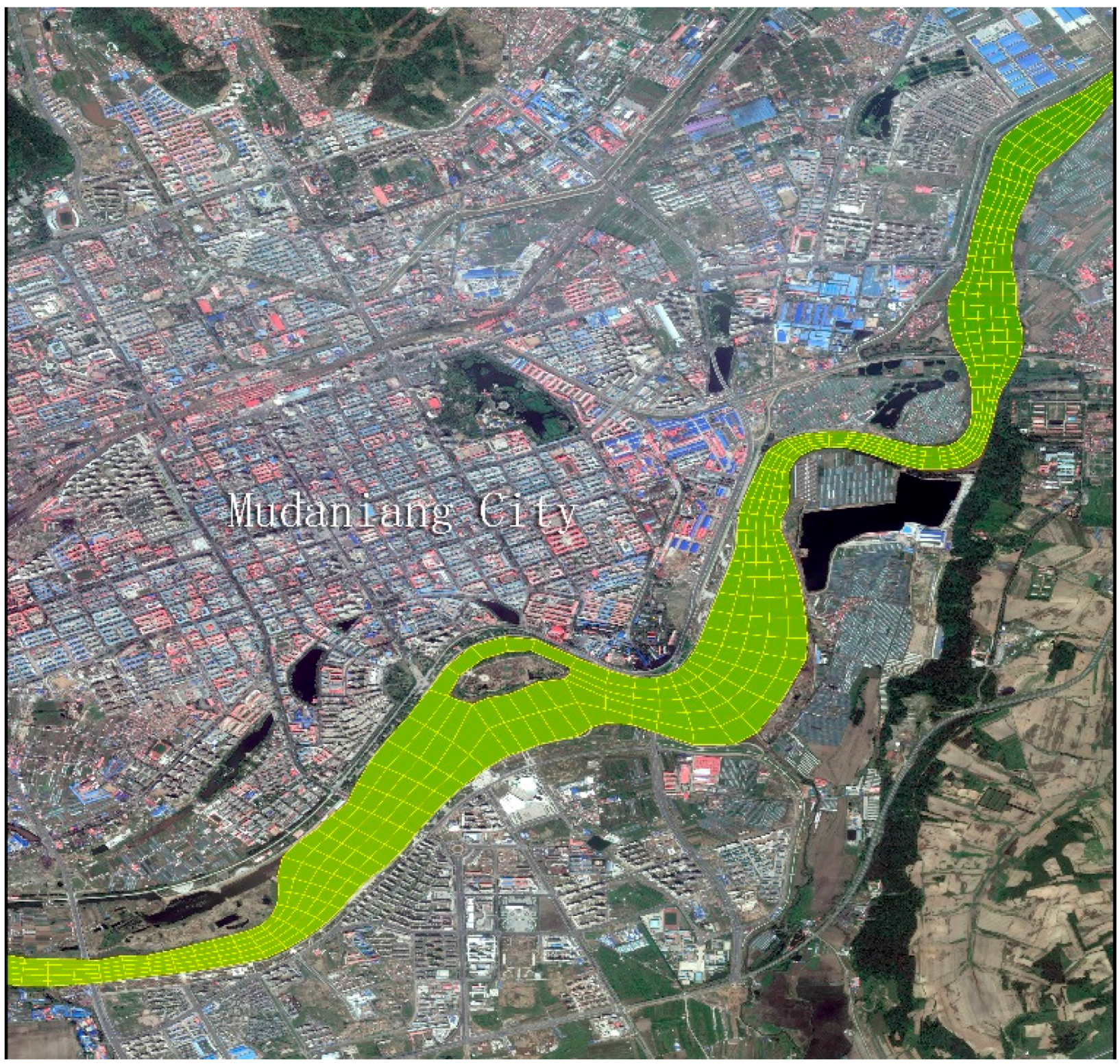
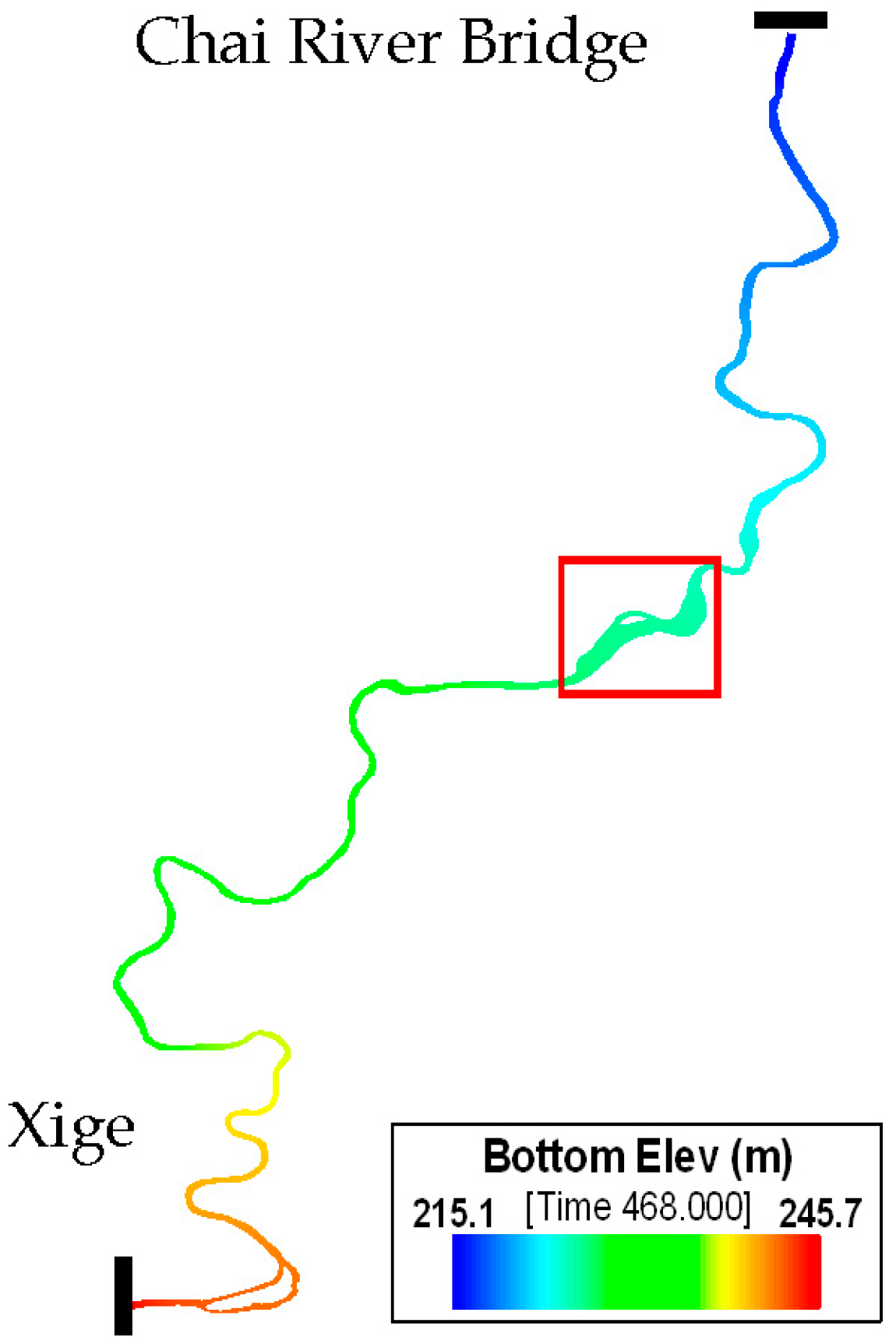
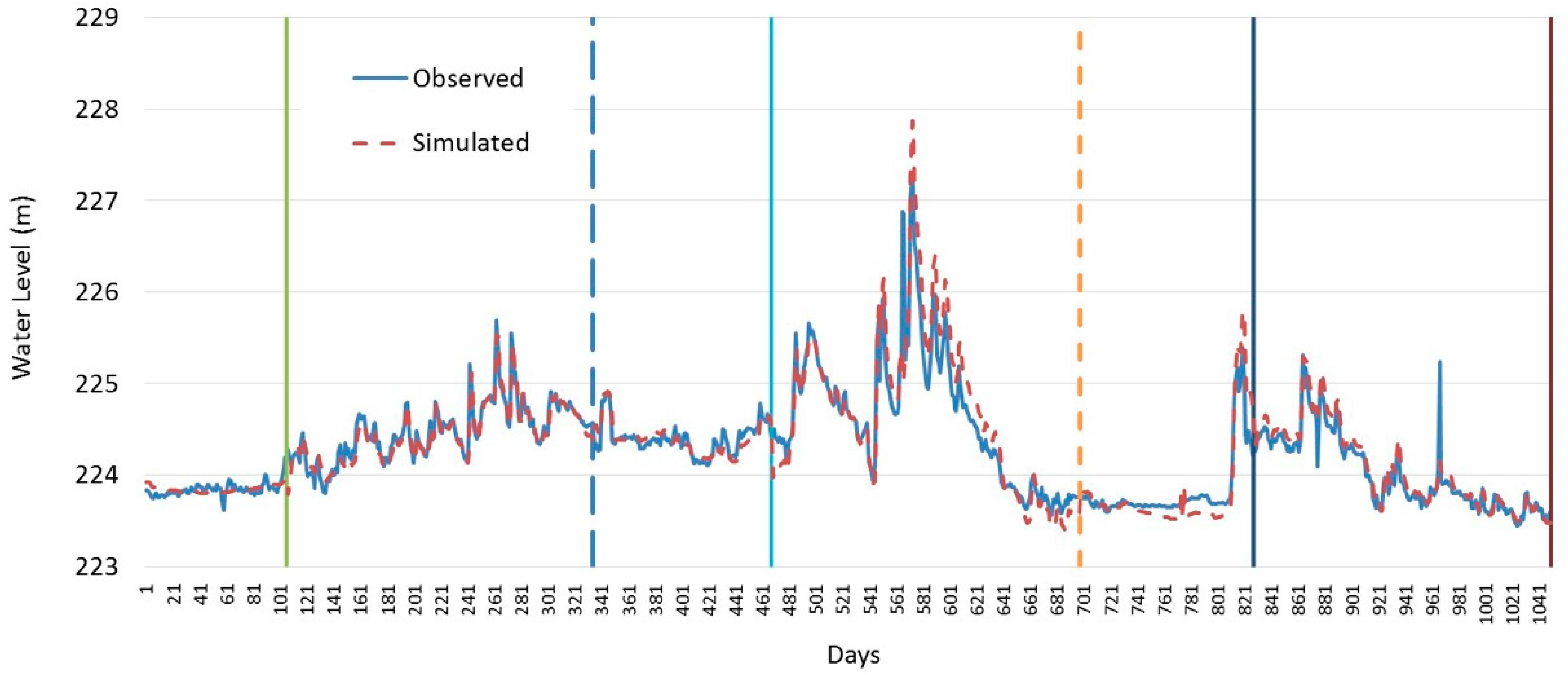
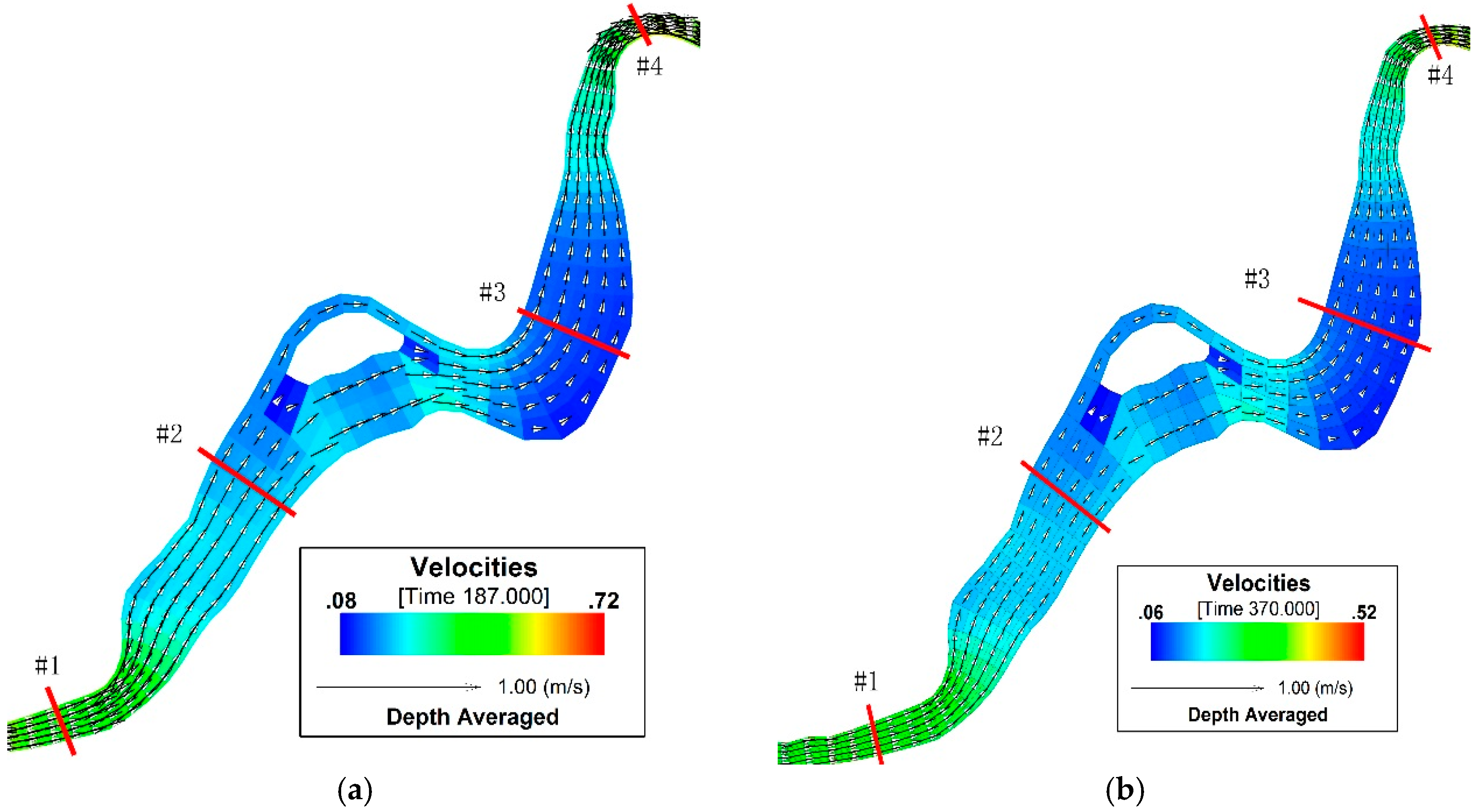
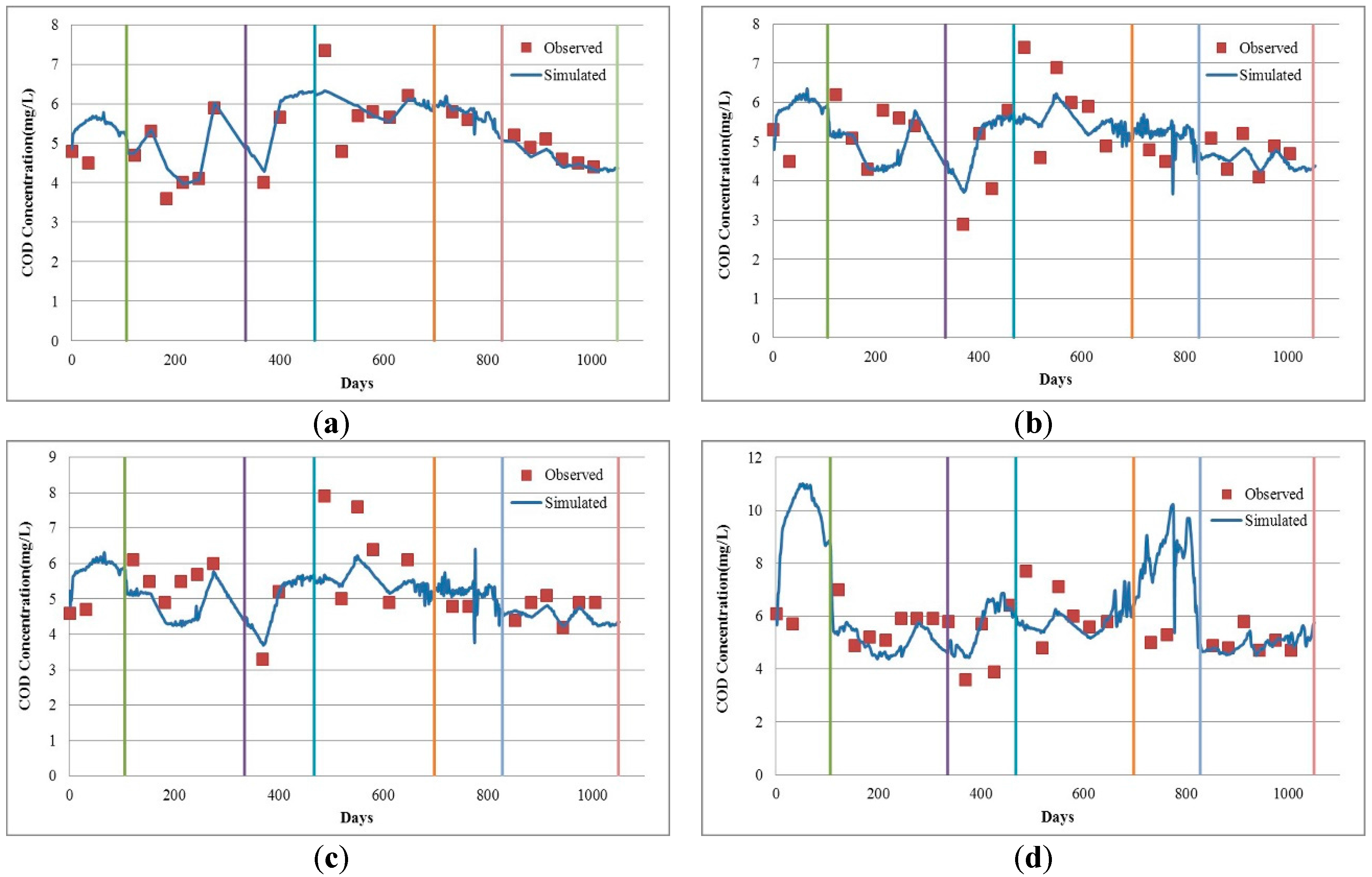
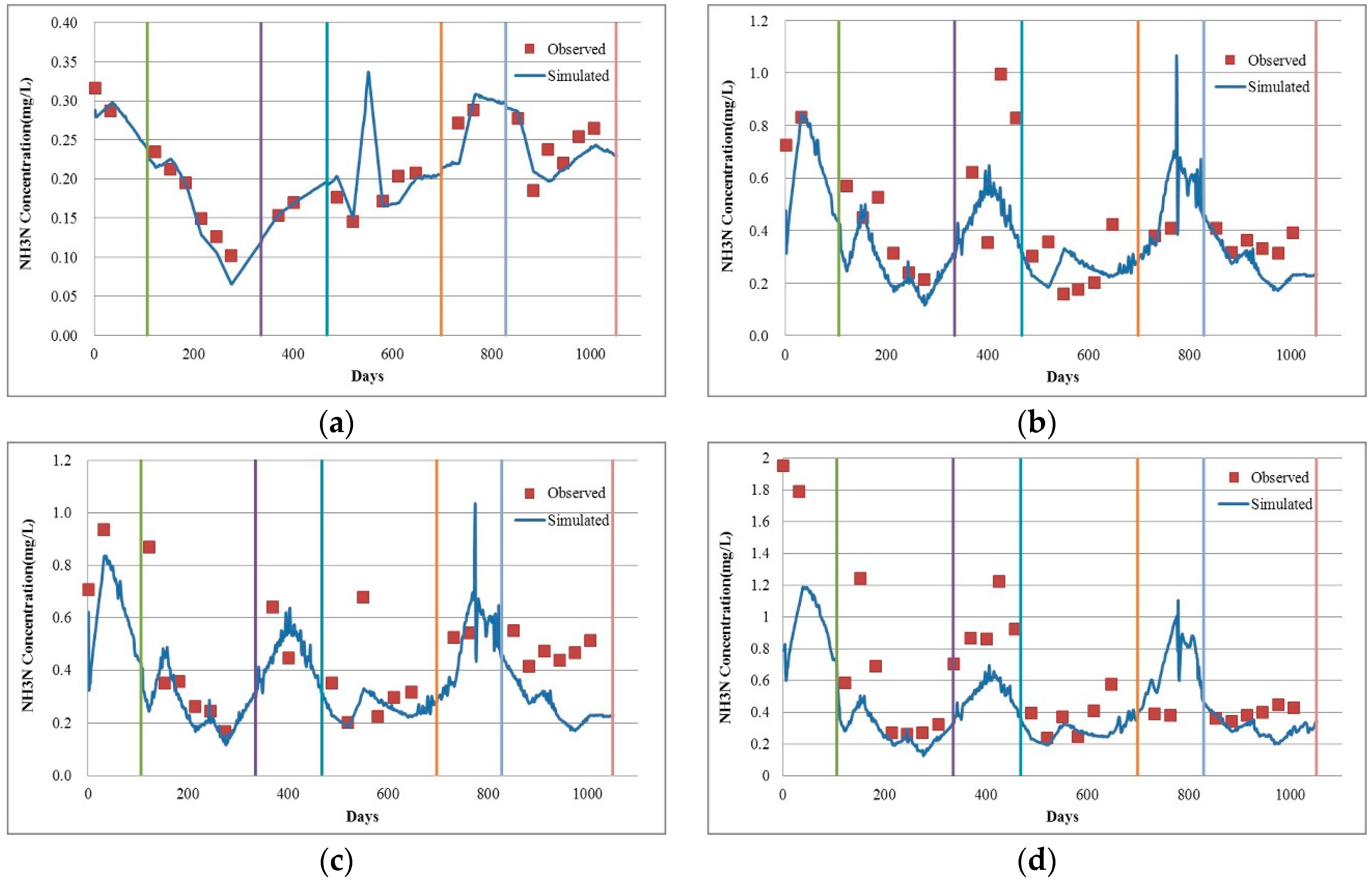
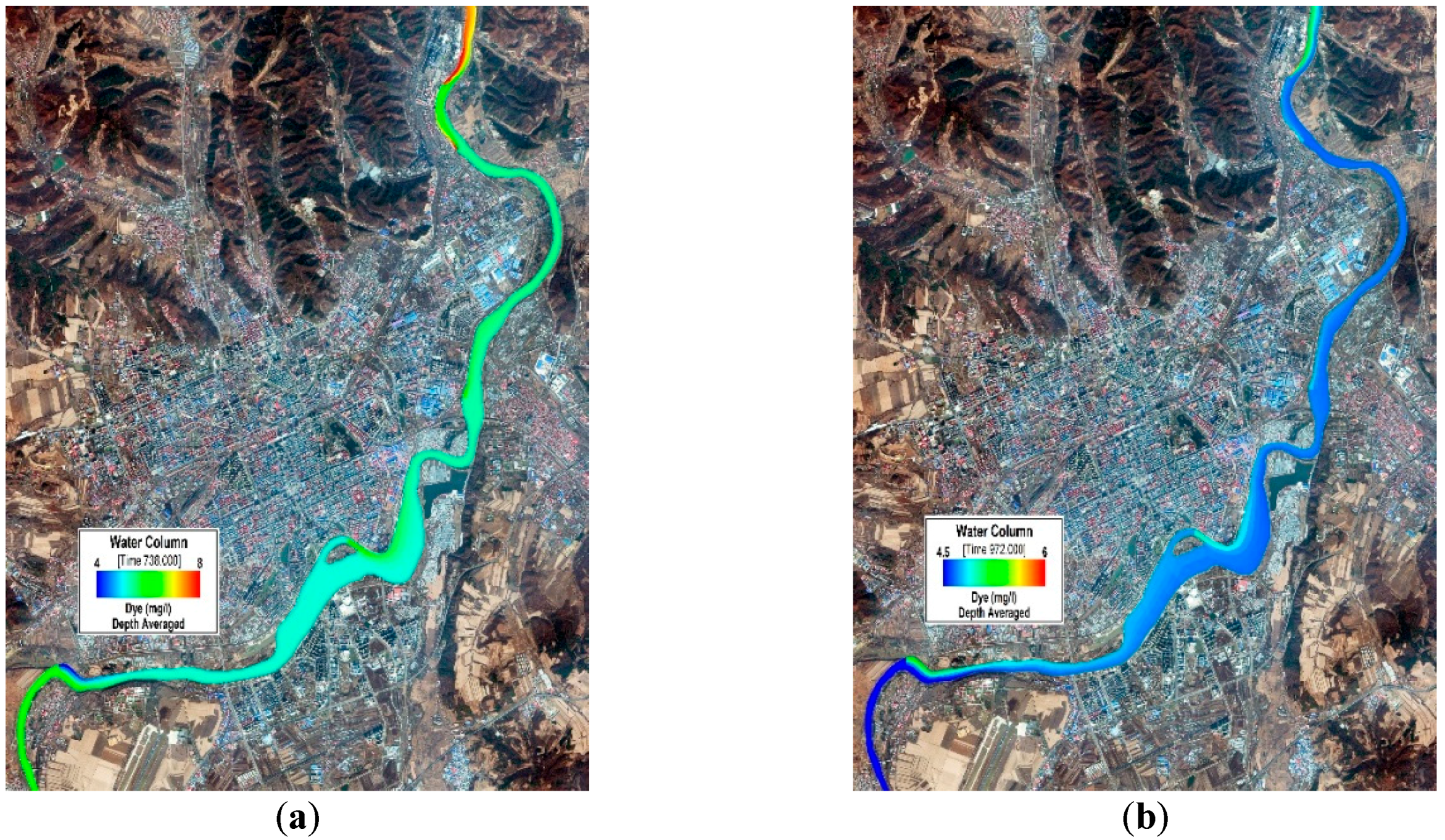
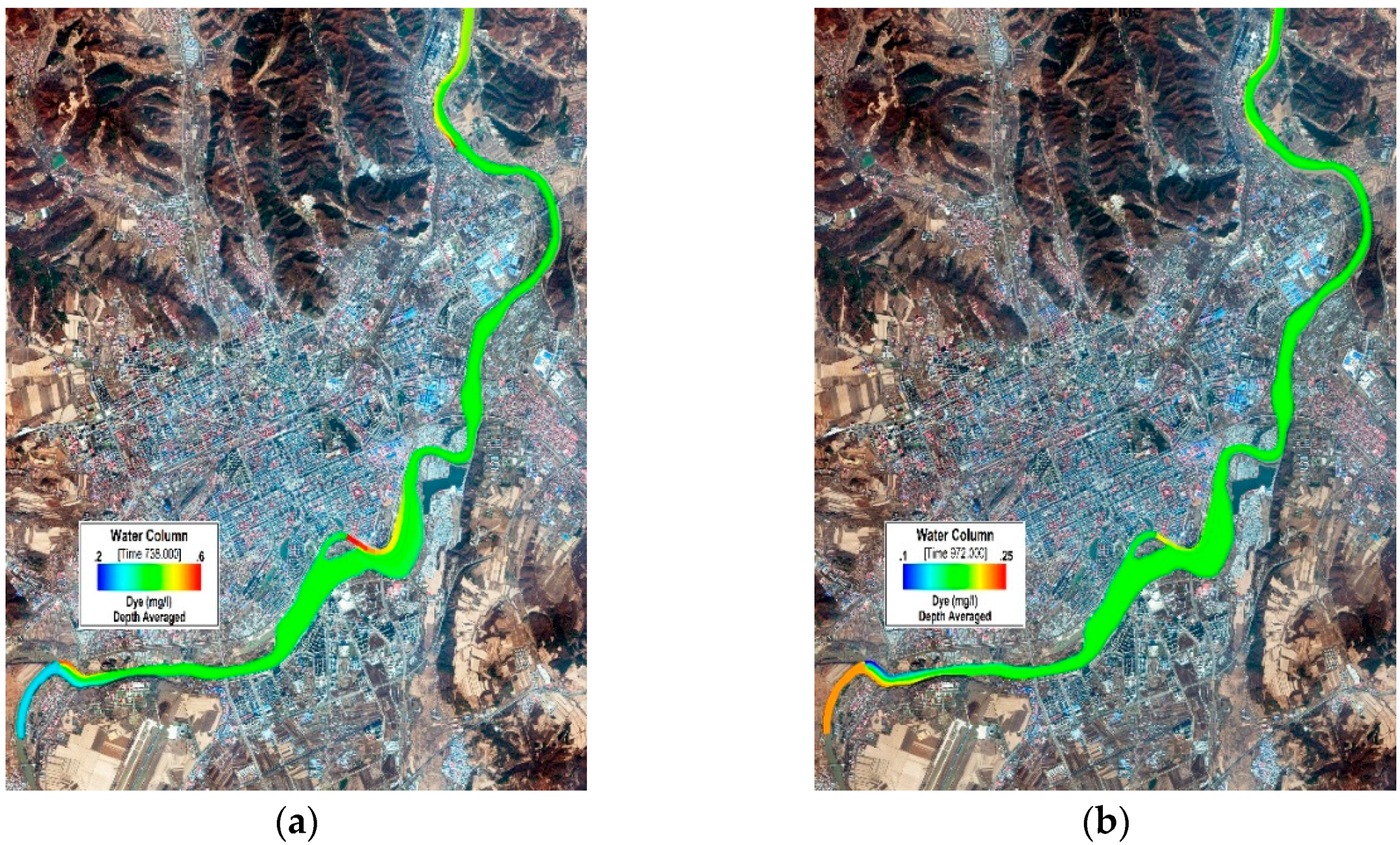
| Simulation Interval (Days) | Number of Days | Water Season | Simulation Interval (Days) | Number of Days | Water Season |
|---|---|---|---|---|---|
| 1–106 | 106 | ice-covered period | 107–335 | 229 | open-water period |
| 336–468 | 133 | ice-covered period | 469–698 | 230 | open-water period |
| 699–828 | 130 | ice-covered period | 829–1050 | 222 | open-water period |
| Simulation Period | Wenchun Bridge | Hailang | Jiangbin Bridge | Chai River Bridge | ||||
|---|---|---|---|---|---|---|---|---|
| Sample Size | Average Relative Error (%) | Sample Size | Average Relative Error (%) | Sample Size | Average Relative Error (%) | Sample Size | Average Relative Error (%) | |
| ice-covered period | 6 | 7.19 | 8 | 17.44 | 6 | 11.53 | 9 | 35.41 |
| open-water period | 18 | 5.42 | 18 | 10.66 | 18 | 11.07 | 19 | 10.39 |
| in total | 24 | 5.86 | 26 | 12.75 | 24 | 11.18 | 28 | 18.43 |
| Simulation Period | Wenchun Bridge | Hailang | Jiangbin Bridge | Chai River Bridge | ||||
|---|---|---|---|---|---|---|---|---|
| Sample Size | Average Relative Error (%) | Sample Size | Average Relative Error (%) | Sample Size | Average Relative Error (%) | Sample Size | Average Relative Error (%) | |
| ice-covered period | 6 | 10.92 | 8 | 35.94 | 6 | 21.66 | 9 | 55.15 |
| open-water period | 17 | 16.28 | 17 | 33.42 | 18 | 35.35 | 19 | 32.32 |
| in total | 23 | 14.88 | 25 | 34.23 | 24 | 31.93 | 28 | 39.58 |
© 2016 by the authors; licensee MDPI, Basel, Switzerland. This article is an open access article distributed under the terms and conditions of the Creative Commons Attribution (CC-BY) license (http://creativecommons.org/licenses/by/4.0/).
Share and Cite
Tang, G.; Zhu, Y.; Wu, G.; Li, J.; Li, Z.-L.; Sun, J. Modelling and Analysis of Hydrodynamics and Water Quality for Rivers in the Northern Cold Region of China. Int. J. Environ. Res. Public Health 2016, 13, 408. https://doi.org/10.3390/ijerph13040408
Tang G, Zhu Y, Wu G, Li J, Li Z-L, Sun J. Modelling and Analysis of Hydrodynamics and Water Quality for Rivers in the Northern Cold Region of China. International Journal of Environmental Research and Public Health. 2016; 13(4):408. https://doi.org/10.3390/ijerph13040408
Chicago/Turabian StyleTang, Gula, Yunqiang Zhu, Guozheng Wu, Jing Li, Zhao-Liang Li, and Jiulin Sun. 2016. "Modelling and Analysis of Hydrodynamics and Water Quality for Rivers in the Northern Cold Region of China" International Journal of Environmental Research and Public Health 13, no. 4: 408. https://doi.org/10.3390/ijerph13040408
APA StyleTang, G., Zhu, Y., Wu, G., Li, J., Li, Z.-L., & Sun, J. (2016). Modelling and Analysis of Hydrodynamics and Water Quality for Rivers in the Northern Cold Region of China. International Journal of Environmental Research and Public Health, 13(4), 408. https://doi.org/10.3390/ijerph13040408







